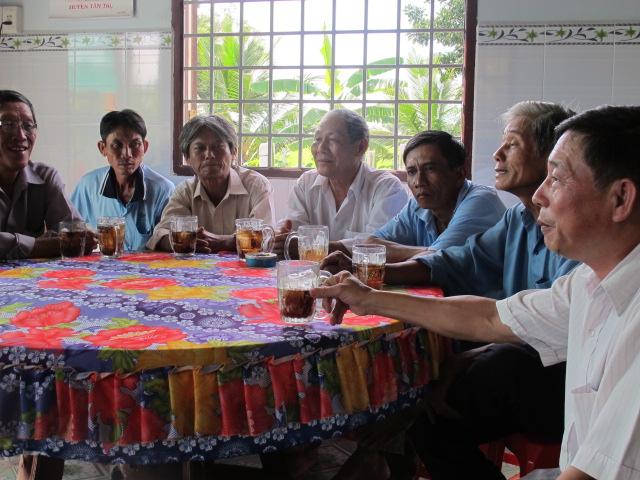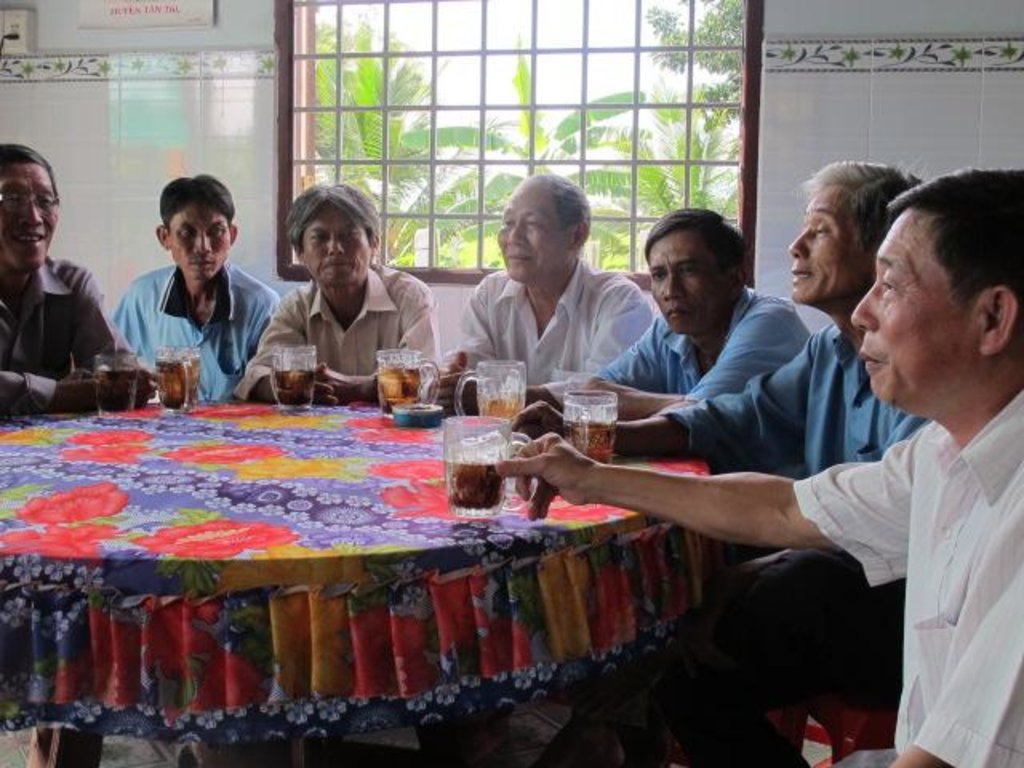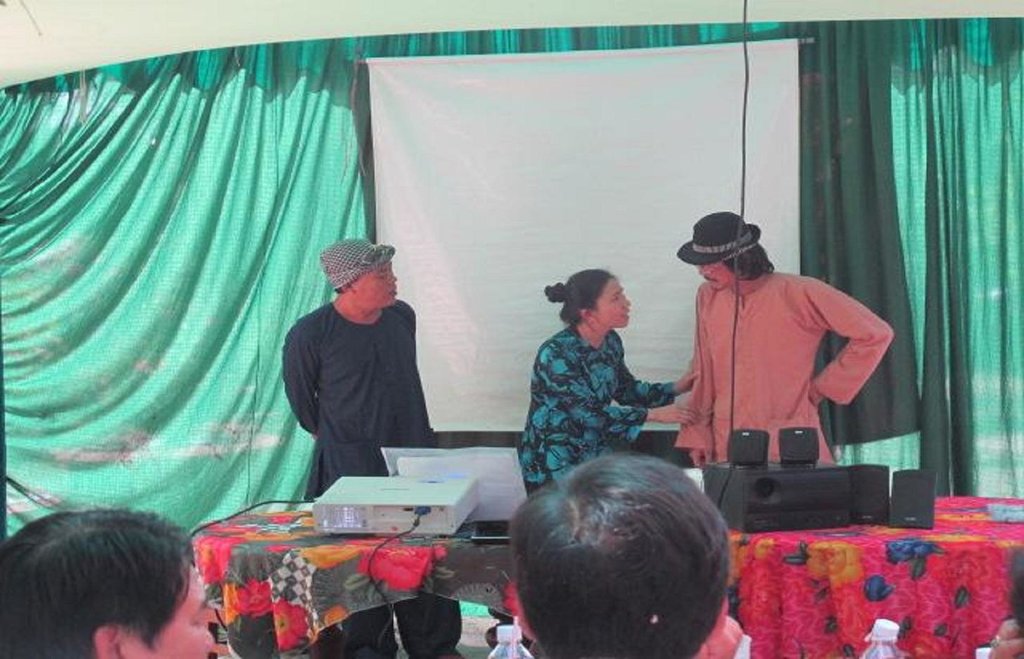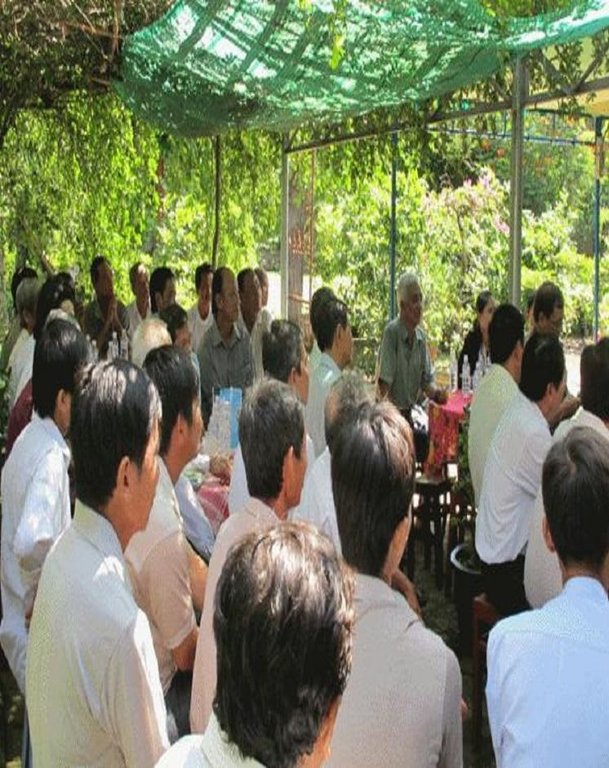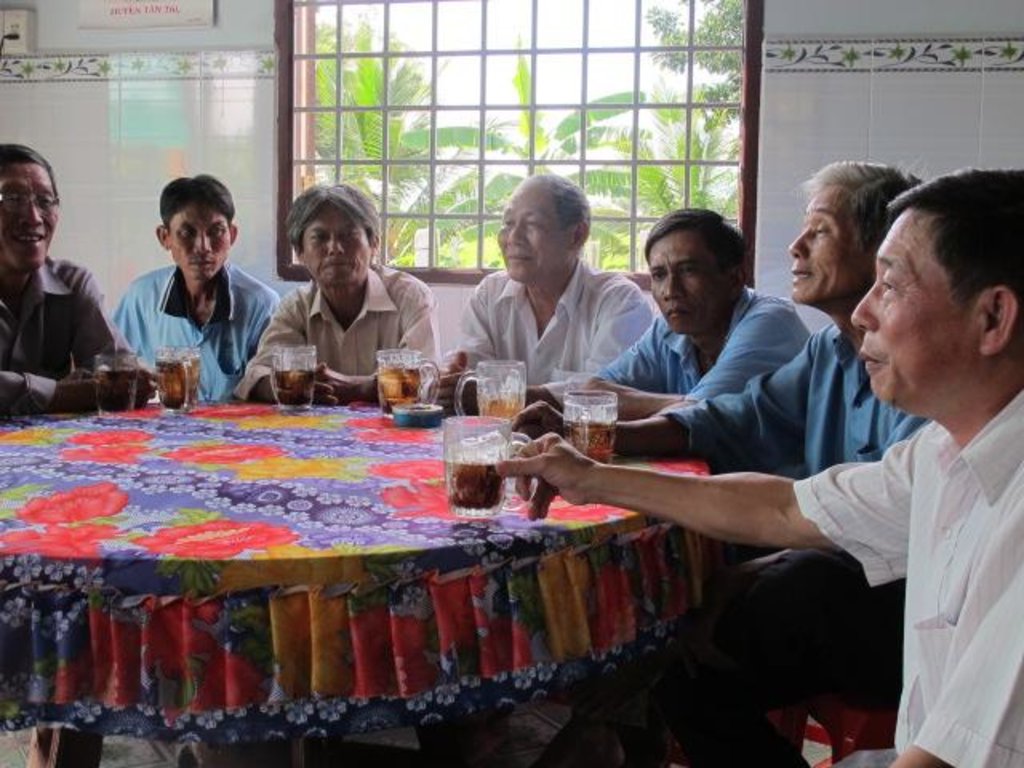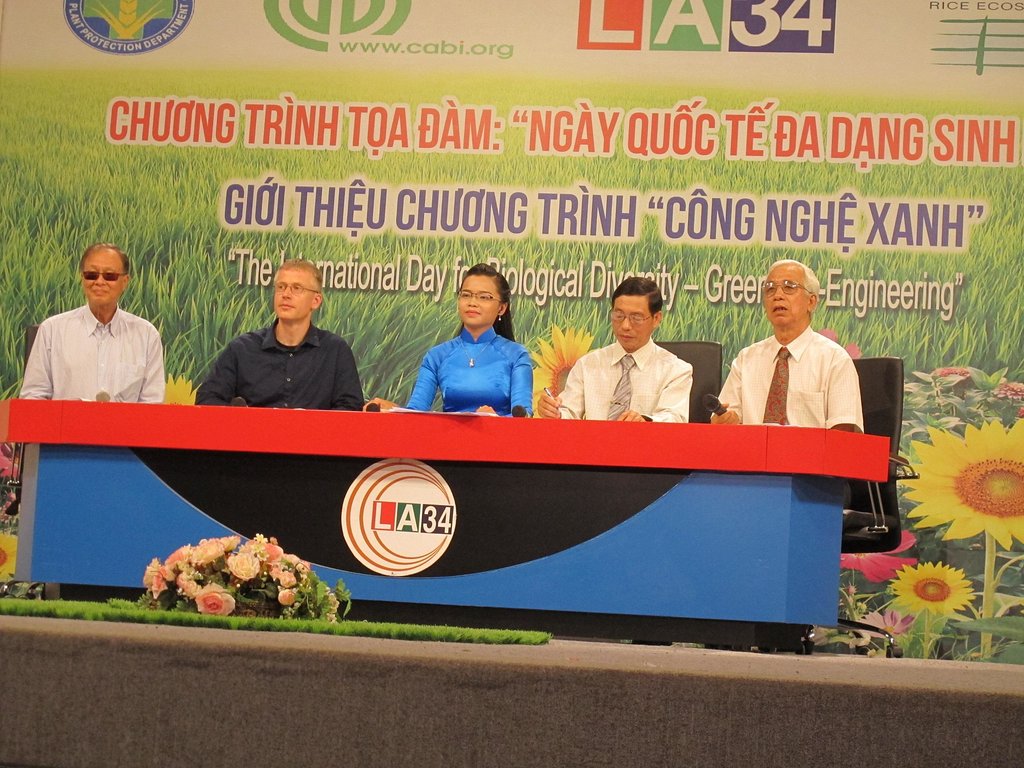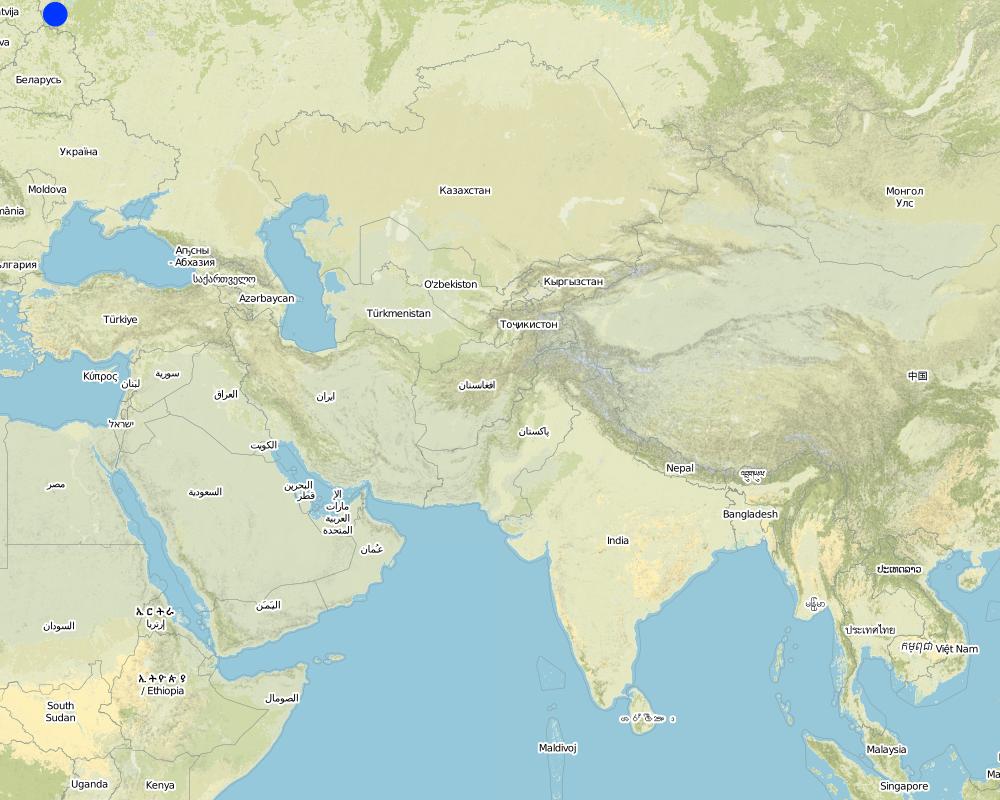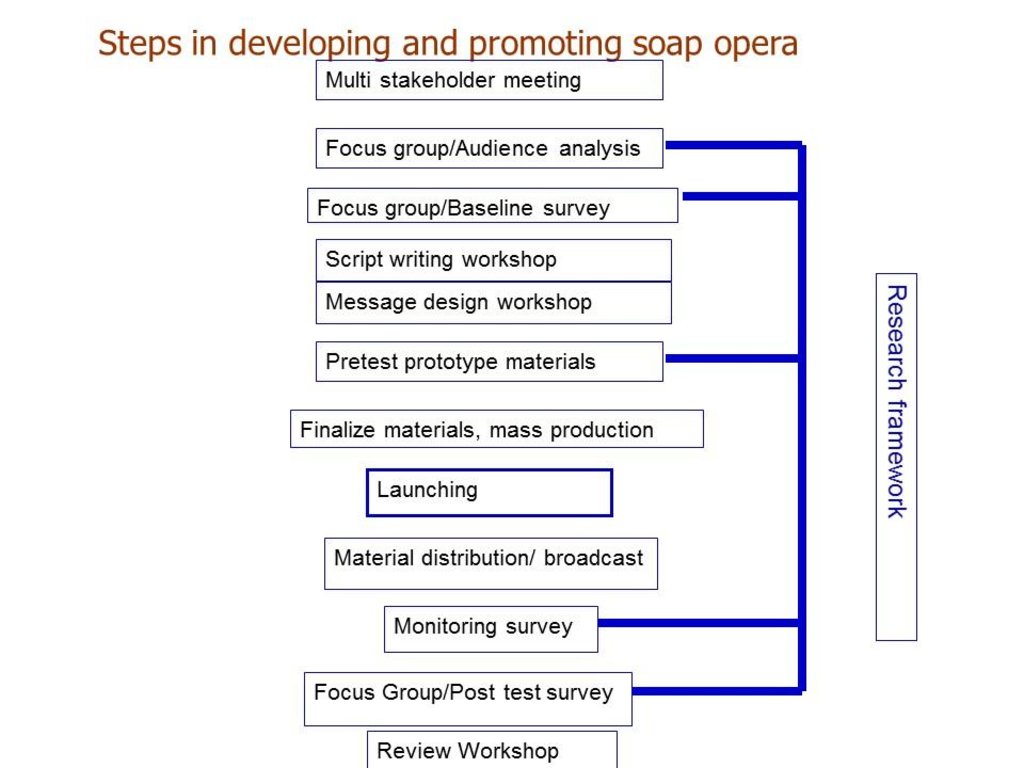Entertainment-education for ecological engineering [ຫວຽດນາມ]
- ການສ້າງ:
- ປັບປູງ:
- ຜູ້ສັງລວມຂໍ້ມູນ: Monina Escalada
- ບັນນາທິການ: –
- ຜູ້ທົບທວນຄືນ: Fabian Ottiger, Deborah Niggli
Cong Nghe Xanh (Vietnamese)
approaches_2613 - ຫວຽດນາມ
ເບິ່ງພາກສ່ວນ
ຂະຫຍາຍທັງໝົດ ຍຸບທັງໝົດ1. ຂໍ້ມູນທົ່ວໄປ
1.2 ລາຍລະອຽດ ການຕິດຕໍ່ ຂອງບຸກຄົນທີ່ຊັບພະຍາກອນ ແລະ ສະຖາບັນ ການມີສ່ວນຮ່ວມ ໃນການປະເມີນຜົນ ແລະ ເອກະສານ ຂອງວິທີທາງ
ຜູ້ຊ່ຽວຊານ ດ້ານການຄຸ້ມຄອງ ທີ່ດິນແບບຍືນຍົງ:
Heong Kong Luen
+60 11-3604 7833
kl.heong@gmail.com
Centre for Agricultural BioSciences International (CABI) South East Asia Regional Centre
PO Box 210, 43400 UPM Serdang
ມາເລເຊຍ
ຜູ້ຊ່ຽວຊານ ດ້ານການຄຸ້ມຄອງ ທີ່ດິນແບບຍືນຍົງ:
Settele Josef
+49(0)345 558 5320
Josef.Settele@ufz.de
Helmholtz-Zentrum für Umweltforschung GmbH - UFZ
Theodor-Lieser-Straße 4 Halle 06120
ເຢຍລະມັນ
ຊື່ຂອງໂຄງການ ທີ່ອໍານວຍຄວາມສະດວກ ໃນການສ້າງເອກກະສານ ຫຼື ປະເມີນດ້ານແນວທາງ (ຖ້າກ່ຽວຂ້ອງ)
Book project: Making sense of research for sustainable land management (GLUES)ຊື່ຂອງ ສະຖາບັນການຈັດຕັ້ງ ທີ່ອໍານວຍຄວາມສະດວກ ໃນການສ້າງເອກກະສານ ຫຼື ປະເມີນແນວທາງ (ຖ້າກ່ຽວຂ້ອງ)
Visayas State University (VSU) - ຟີລິປິນຊື່ຂອງ ສະຖາບັນການຈັດຕັ້ງ ທີ່ອໍານວຍຄວາມສະດວກ ໃນການສ້າງເອກກະສານ ຫຼື ປະເມີນແນວທາງ (ຖ້າກ່ຽວຂ້ອງ)
Helmholtz Centre for Environmental Research (UFZ) - ເຢຍລະມັນຊື່ຂອງ ສະຖາບັນການຈັດຕັ້ງ ທີ່ອໍານວຍຄວາມສະດວກ ໃນການສ້າງເອກກະສານ ຫຼື ປະເມີນແນວທາງ (ຖ້າກ່ຽວຂ້ອງ)
Centre for Agricultural BioSciences International (CABI) - ລາຊະອານາຈັກອັງກິດ1.3 ເງື່ອນໄຂ ຂອງການນໍາໃຊ້ເອກກະສານຂໍ້ມູນ ຂອງ WOCAT
ຜູ້ສັງລວມ ແລະ ບັນດາຜູ້ຕອບແບບສອບຖາມ ຍອມຮັບໃນເງື່ອນໄຂ ການນໍາໃຊ້ຂໍ້ມູນເອກະສານ ທີ່ສ້າງຂື້ນ ໂດຍຜ່ານ ອົງການ WOCAT:
ແມ່ນ
2. ພັນລະນາ ແນວທາງການຄຸ້ມຄອງນໍາໃຊ້ດິນແບບຍືນຍົງ
2.1 ການອະທິບາຍ ໂດຍຫຍໍ້ ຂອງວິທີທາງ
Entertainment-education for ecological engineering involves a series of TV pro-grammes that educate rice farmers about ecosystem services, as well as ecologi-cal engineering techniques to conserve biodiversity in rice landscapes.
2.2 ການອະທິບາຍ ລາຍລະອຽດ ຂອງວິທີທາງ
ການອະທິບາຍ ລາຍລະອຽດ ຂອງວິທີທາງ:
Aims / objectives: A multi-stakeholder participatory process was adopted in formative research, then designing and developing a soap-opera series, launching the programme, followed by implementing on-the-ground support, and monitoring of progress. The stakeholders involved were from research, extension, a video production company and local government. To make sure the educational content was accurately and seamlessly woven into drama, the collaborating team was composed of technical experts and scriptwriters, nicknamed the ‘‘turtles and peacocks’’. Each 15-minute episode is composed of 3 parts: a short drama by comedians, an explanation by experts, and then a summary of the lesson portrayed in that particular episode.
Methods: The LEGATO TV series was produced by Viet Idea, a video company based in Ho Chi Minh City, and was broadcast on Long An TV (LA34) weekly for 20 weeks. The 18 episodes were based on the values grid that LEGATO scientists had developed. They covered a range of topics including organic matter decomposition, organisms and microorganisms, straw burning, rural habitats, the food chain, the architecture of traditional houses, the role of silicon in rice production, honey bees, plant health, eco-tourism and eco-engineering.
Stages of implementation: To popularize and enhance the viewership of the LEGATO Ecological Engineering TV series, a “Meet the Actors Day” was organized in Khanh Hau village, Tan An Town, Long An Province. The organisers comprised “Cong Nghe Xanh”, Long An TV (LA34), Y Tuong Viet (Idea Vietnam), and the Southern Regional Plant Protection Centre. The event was attended by the village People’s Committee Chair, farmers, Long An TV staff and plant protection officers. The “Meet the Actors” day is one of the elements in the entertainment-education approach. To track viewership and audience reactions to the TV series, four focus group discussions (FGDs) were conducted with 41 rice farmers in four villages in Long An province. A post-broadcast survey was carried out in January 2015 among 396 randomly selected rice farmers in Long An and Tien Giang Provinces.
Role of stakeholders: The role of the different stakeholders in the approach was as follows: 1) Farmers provided feedback on the relevance and usefulness of the TV episodes and sug-gested other topics; 2) Plant protection officers worked with TV episode scriptwriters and served as subject matter specialists to simplify the educational content of each episode; 3) Local plant protection experts provided the scientific explanation behind the topics tackled in the episodes; 4) Local government was represented by Dr Nguyen Van Khang, former Director of Agriculture in Tien Giang province who agreed to allocate a portion of the provincial pesticide budget into ecological engineering demonstrations as he required data to be generated locally. Since then, from 2010 to 2014, more demonstration fields were set up.
Other important information: Preliminary analyses showed no significant differences in farmers’ insecticide use, but significant differences were found in beliefs and positions about growing flowers, biocontrol, and silicon use. A follow-up farmer survey was conducted to further eval-uate the effects of the TV series on rice farmers in Tien Giang and Long An Provinces.
2.3 ຮູບພາບຂອງແນວທາງ
2.5 ປະເທດ / ເຂດ / ສະຖານທີ່ບ່ອນທີ່ແນວທາງໄດ້ຖືກນໍາໃຊ້
ປະເທດ:
ຫວຽດນາມ
ພາກພື້ນ / ລັດ / ແຂວງ:
Long An and Tien Giang
ຂໍ້ມູນເພີ່ມເຕີມຂອງສະຖານທີ່:
Tan An town, Tan Tru, Thu Thua, Ben Luc, Chau Thanh,Tan Phuoc, Cai Lay
Map
×2.6 ວັນທີເລີ່ມຕົ້ນ ແລະ ສິ້ນສຸດ ການຈັດຕັ້ງປະຕີບັດ ວິທີທາງ
ສະແດງປີຂອງການເລີ່ມຕົ້ນ:
2014
ປີທີ່ສີ້ນສູດ (ຖ້າຢຸດບໍ່ໄດ້ນໍາໃຊ້ ວິທີທາງ):
2016
2.7 ປະເພດຂອງແນວທາງ
- ການລິເລີ່ມ ພາຍໃນປະເທດ ທີ່ຜ່ານມາ / ນະວັດຕະກໍາ
2.8 ເປົ້າໝາຍ / ຈຸດປະສົງຫຼັກ ຂອງການຈັດຕັ້ງປະຕິບັດ ວິທີທາງ
The Approach focused on SLM only (reducing insecticide use, restoring biodiversity in rice landscapes )
Improve farmers’ pest management, reduce their insecticide use and improve their land use to include conservation of biodiversity.
The SLM Approach addressed the following problems: Lack of funds to support SLM; Unregulated pesticide marketing continues to negate the gains obtained by SLM.
2.9 ເງື່ອນໄຂອໍານວຍ ຫຼື ຂັດຂວາງການປະຕິບັດຂອງເຕັກໂນໂລຢີ / ເຕັກໂນໂລຢີການນໍາໃຊ້ຕາມແນວທາງ
ສັງຄົມ / ວັດທະນະທໍາ / ມາດຕະຖານ ແລະ ຄຸນຄ່າທາງສາສະໜາ
- ເຊື່ອງຊ້ອນ
Educate farmers to appreciate parasitoids that are too tiny to be seen by the naked eye.
Treatment through the SLM Approach: As the parasitoids and bees belong to the same insect group, hymenoptera, we associated parasitoids with bees that farmers are familiar with.
ມີຄວາມສາມາດ / ເຂັ້າເຖິງຊັບພະຍາກອນດ້ານການເງິນ ແລະ ການບໍລິການ
- ເຊື່ອງຊ້ອນ
Funds to support education system.
Treatment through the SLM Approach: Encourage local governments to provide support.
ການກໍ່ຕັ້ງສະຖາບັນ
- ເຊື່ອງຊ້ອນ
Lack of direct linkage between agricultural and TV broadcast stations.
Treatment through the SLM Approach: Use stakeholder meetings and field activities to establish these new links.
ກ່ຽວກັບກົດໝາຍ (ສິດນໍາໃຊ້ດິນ, ສິດນໍາໃຊ້ນໍ້າ)
- ອໍານວຍ
The existing land ownership, land use rights / water rights helped a little the approach implementation
ຄວາມຮູ້ກ່ຽວກັບການຄຸ້ມຄອງ ທີ່ດິນແບບຍືນຍົງ, ການເຂົ້າເຖິງການສະໜັບສະໜູນ ທາງດ້ານວິຊາການ
- ເຊື່ອງຊ້ອນ
Technical information.
Treatment through the SLM Approach: Explore research findings for information.
ວຽກ, ມີກໍາລັງຄົນ
- ເຊື່ອງຊ້ອນ
Lack of work force dedicated to this entertainment-education process.
Treatment through the SLM Approach: Encourage provincial government to allocate more staff who can simplify and disseminate scientific information.
ອື່ນໆ
- ເຊື່ອງຊ້ອນ
Unregulated pesticide sales continue to erode gains from education.
Treatment through the SLM Approach: Encourage government to review and reform current pesticide sales regulations.
3. ການມີສ່ວນຮ່ວມ ແລະ ບົດບາດຂອງພາກສ່ວນທີ່ກ່ຽວຂ້ອງທີ່ໄດ້ມີສ່ວນຮ່ວມ
3.1 ຜູ້ມີສ່ວນຮ່ວມ ໃນວິທີທາງ ແລະ ພາລະບົດບາດ ຂອງເຂົາເຈົ້າ
- ຜູ້ນໍາໃຊ້ດິນໃນທ້ອງຖິ່ນ / ຊຸມຊົນທ້ອງຖິ່ນ
Communication specialist (female), regional director of plant protection (male), ecologist (male)
Farmers, male and female, Vietnamese
- ຜູ້ຊ່ຽວຊານ ການນຄຸ້ມຄອງ ທີ່ດິນແບບຍືນຍົງ / ທີ່ປຶກສາດ້ານກະສິກໍາ
Ecologist (male), plant protection director (male)
- ນັກຄົ້ນຄວ້າ
Visayas State University, Leyte, Philippines
- ອໍານາດ ການປົກຄອງທ້ອງຖິ່ນ
Local government of Long An province
People's Committee chair (provincial)
- ພະນັກງານຂັ້ນສູນກາງ (ຜູ້ວາງແຜນ, ຜູ້ສ້າງນະໂຍບາຍ)
- ອົງການຈັດຕັ້ງ ສາກົນ
Center for Agricultural BioSciences International (CABI), Malaysia
3.2 ການມີສ່ວນຮ່ວມຂອງຜູ້ນໍາໃຊ້ທີ່ດິນໃນທ້ອງຖິ່ນ / ຊຸມຊົນທ້ອງຖິ່ນໃນໄລຍະທີ່ແຕກຕ່າງກັນຂອງແນວທາງ
| ການລວບລວມ ເອົາຜູ້ນໍາໃຊ້ດິນ ໃນທ້ອງຖິ່ນ / ຊຸມຊົນທ້ອງຖິ່ນ | ໃຫ້ລະບຸ ຜູ້ໃດທີ່ມີສ່ວນຮ່ວມ ໃນແຕ່ລະກິດຈະກໍາ? | |
|---|---|---|
| ການເລີ່ມຕົ້ນ / ແຮງຈູງໃຈ | ການບໍ່ປະຕິບັດ | SLM promoters |
| ການວາງແຜນ | ການຮ່ວມມື | All stakeholders |
| ການປະຕິບັດ | ການນໍາໃໍຊ້ເອງ | All stakeholders |
| ຕິດຕາມກວດກາ / ການປະເມີນຜົນ | ການນໍາໃໍຊ້ເອງ | SLM promoters and local implementers |
| Research | ການຮ່ວມມື | SLM promoters |
3.3 ແຜນວາດ (ຖ້າມີ)
ການອະທິບາຍ:
Steps in developing and promoting a soap opera
ຜູ້ຂຽນ:
Kong Luen Heong, Monina Escalada (CABI, Kuala Lumpur; Visayas State University)
3.4 ການຕັດສິນໃຈກ່ຽວກັບການຄັດເລືອກເຕັກໂນໂລຢີຂອງການຄຸ້ມຄອງທີ່ດິນແບບຍືນຍົງ / ເຕັກໂນໂລຢີ
ລະບຸ ຄົນທີ່ຕັດສິນໃຈ ກ່ຽວກັບການຄັດເລືອກຂອງ ເຕັກໂນໂລຢີ / ເຕັກໂນໂລຢີ ຈະໄດ້ຮັບການປະຕິບັດ:
- ຜູ້ຊ່ຽວຊານ ຫຼັກດ້ານການຄຸ້ມຄອງ ທີ່ດິນແບບຍືນຍົງ, ມີການຕິດຕາມປຶກສາຫາລືກັບຜູ້ນໍາໃຊ້ທີ່ດິນ
ອະທິບາຍ:
A stakeholder consultation workshop was organized at the initial stage.
Decisions on the method of implementing the SLM Technology were made by mainly by SLM specialists with consultation of land users. Through stakeholder consultation and focus group discussions
4. ການສະໜັບສະໜູນທາງດ້ານວິຊາການ, ການສ້າງຄວາມສາມາດ, ແລະ ການຈັດການຄວາມຮູ້.
4.1 ການສ້າງຄວາມສາມາດ / ການຝຶກອົບຮົມ
ຜູ້ນໍາໃຊ້ທີ່ດິນ ຫຼື ພາກສ່ວນກ່ຽວຂ້ອງອື່ນໆ ໄດ້ຮັບການຝຶກອົບຮົມບໍ່?
ແມ່ນ
ໃຫ້ລະບຸ ຜູ້ໃດທີ່ໄດ້ຮັບການຝຶກອົບຮົມ:
- ຜູ້ນໍາໃຊ້ດິນ
- ພະນັກງານພາກສະໜາມ / ທີ່ປຶກສາ
ຮູບແບບຂອງການຝຶກອົບຮົມ:
- ການເຮັດຕົວຈິງ
- ຕົວຕໍ່ຕົວ
- ເນື້ອທີ່ສວນທົດລອງ
- ກອງປະຊຸມ
ຮູບແບບຂອງການຝຶກອົບຮົມ:
- Communication campaign
ໃນຫົວຂໍ້:
Principles of ecological engineering and pest management
4.2 ການບໍລິການໃຫ້ຄໍາປຶກສາ
ເຮັດຜູ້ໃຊ້ທີ່ດິນມີການເຂົ້າເຖິງການບໍລິການໃຫ້ຄໍາປຶກສາ?
ແມ່ນ
- Consultation
4.3 ສະຖາບັນການສ້າງຄວາມເຂັ້ມແຂງ (ການພັດທະນາອົງການຈັດຕັ້ງ)
ສະຖາບັນ ໄດ້ຮັບການສ້າງຕັ້ງຂື້ນ ຫຼື ໄດ້ຮັບການສ້າງຄວາມເຂັ້ມແຂງ ໂດຍການຈັດຕັ້ງປະຕິບັດ ວິທີທາງບໍ່?
- ບໍ່ມີ
4.4 ຕິດຕາມກວດກາ ແລະ ປະເມີນຜົນ
ການຈັດຕັ້ງປະຕິບັດ ວິທີທາງ ໄດ້ມີການປະເມີນຜົນ ແລະ ຕິດຕາມບໍ?
ແມ່ນ
ຄວາມຄິດເຫັນ:
socio-cultural aspects were regular monitored by land users through observations
socio-cultural aspects were regular monitored by land users through measurements
There were no changes in the Approach as a result of monitoring and evaluation
There were no changes in the Technology as a result of monitoring and evaluation
4.5 ການຄົ້ນຄວ້າ
ນີ້້ແມ່ນສ່ວນໜຶ່ງ ການຄົ້ນຄວ້າ ຂອງວິທີທາງບໍ່?
ແມ່ນ
ລະບຸ ຫົວຂໍ້:
- ລະບົບນິເວດ
ໃຫ້ຂໍ້ມູນ ເພີ່ມເຕີມ ແລະ ກໍານົດ ຜູ້ໃດເຮັດການຄົ້ນຄວ້າ:
Research was carried out on-farm
5. ການສະໜັບສະໜູນທາງດ້ານການເງິນ ແລະ ອຸປະກອນຈາກພາຍນອກ
5.1 ງົບປະມານປະຈໍາປີ ສໍາລັບວິທີທາງ ຂອງການຄຸ້ມຄອງ ທີ່ດິນແບບຍືນຍົງ
ຖ້າຫາກບໍ່ຮູ້ຈັດງົບປະມານທີ່ແນ່ນອນ ແມ່ນໃຫ້ປະມານເອົາ:
- 10,000-100,000
ຄໍາເຫັນ (ຕົວຢ່າງ: ແຫຼ່ງຂໍ້ມູນຫຼັກ ຂອງການສະໜອງທຶນ / ຜູ້ໃຫ້ທຶນທີ່ສໍາຄັນ):
Approach costs were met by the following donors: international (German Ministry of Education and Research, BMBF (70,000 USD)): 70.0%; government (30,000 USD): 30.0%
5.2 ການສະໜັບສະໜູນ ທາງດ້ານການເງິນ / ອຸປະກອນ ສະໜອງໃຫ້ແກ່ຜູ້ນໍາທີ່ດິນ
ຜູ້ນໍາໃຊ້ດິນ ໄດ້ຮັບການສະໜັບສະໜູນ ທາງດ້ານ ການເງິນ / ອຸປະກອນ ໃນການຈັດຕັ້ງປະຕິບັດ ເຕັກໂນໂລຢີບໍ?
ແມ່ນ
5.3 ເງິນສົມທົບສໍາລັບການນໍາໃຊ້ສະເພາະປັດໃຈຂາເຂົ້າໃນການຜະລີດກະສິກໍາ (ລວມທັງແຮງງານ)
- ກະສິກໍາ
| ໃຫ້ລະບຸໄດ້ຮັບການສະໜັບສະໜູນປັດໃຈຂາເຂົ້າຫຍັງແດ່ | ທີ່ຂອບເຂດ | ລະບຸ ການອຸດໜູນ |
|---|---|---|
| Flower seedlings | ງົບປະມານບາງສ່ວນ | |
ຖ້າແຮງງານ ຂອງຜູ້ນໍາໃຊ້ດິນ ໄດ້ຮັບການສະໜັບສະໜູນ ປັດໃຈຂາເຂົ້າ, ແມ່ນບໍ່:
- ການອາສາ
5.4 ສິນເຊື່ອ
ໄດ້ປ່ອຍສິນເຊື່ອ ສະໜອງໃຫ້ພາຍໃຕ້ ວິທີການສໍາລັບກິດຈະກໍາ ການຄຸ້ມຄອງ ທີ່ດິນແບບຍືນນຍົງບໍ່?
ບໍ່ແມ່ນ
6. ວິເຄາະຜົນກະທົບ ແລະ ສັງລວມບັນຫາ
6.1 ຜົນກະທົບຂອງແນວທາງ
ການຈັດຕັ້ງປະຕິບັດ ວິທີທາງ ສາມາດຊ່ວຍຜູ້ນໍາໃຊ້ທີ່ດິນ ໃນການຈັດຕັ້ງປະຕິບັດ ແລະ ບໍາລຸງຮັກສາ ເຕັກໂນໂລຢີ ການຄຸ້ມຄອງ ທີ່ດິນແບບຍືນຍົງໄດ້ບໍ?
- ບໍ່
- ມີ, ໜ້ອຍໜຶ່ງ
- ມີ, ພໍສົມຄວນ
- ມີ, ຫຼາຍ
Reduction in fertilizer and pesticide use
ການຈັດຕັ້ງປະຕິບັດ ວິທີທາງ ສາມາດສ້າງຄວາມເຂັ້ມແຂງ ທາງສັງຄົມ ແລະ ເສດຖະກິດບໍ່?
- ບໍ່
- ມີ, ໜ້ອຍໜຶ່ງ
- ມີ, ພໍສົມຄວນ
- ມີ, ຫຼາຍ
ການຈັດຕັ້ງປະຕິບັດ ວິທີທາງ ສາມາດປັບປຸງ ປະເດັນການຖືຄອງທີ່ດິນ / ສິດທິໃນການນໍາໃຊ້ທີ່ດິນ ທີ່ເຊື່ອງຊ້ອນໃນການຈັດຕັ້ງປະຕິບັດ ເຕັກໂນໂລຢີ ການຄຸ້ມຄອງ ທີ່ດິນແບບຍືນຍົງໄດ້ບໍ?
- ບໍ່
- ມີ, ໜ້ອຍໜຶ່ງ
- ມີ, ພໍສົມຄວນ
- ມີ, ຫຼາຍ
The problem is likely to be overcome in the near future.
Did other land users / projects adopt the Approach?
- ບໍ່
- ມີ, ໜ້ອຍໜຶ່ງ
- ມີ, ພໍສົມຄວນ
- ມີ, ຫຼາຍ
Did the Approach lead to improved livelihoods / human well-being?
- ບໍ່
- ມີ, ໜ້ອຍໜຶ່ງ
- ມີ, ພໍສົມຄວນ
- ມີ, ຫຼາຍ
Did the Approach help to alleviate poverty?
- ບໍ່
- ມີ, ໜ້ອຍໜຶ່ງ
- ມີ, ພໍສົມຄວນ
- ມີ, ຫຼາຍ
6.2 ແຮງຈູງໃຈຫຼັກຂອງຜູ້ນໍາໃຊ້ທີ່ດິນໃນການປະຕິບັດການຄຸ້ມຄອງທີ່ດິນແບບຍືນຍົງ
- ການຜະລິດເພີ່ມຂຶ້ນ
- ກໍາໄລເພີ່ມຂຶ້ນ (ຄວາມສາມາດ), ການປັບປຸງຄ່າໃຊ້ຈ່າຍ, ຜົນປະໂຫຍດ, ອັດຕາສ່ວນ
- ຄວາມຮັບຮູ້ ທາງສີ່ງແວດລ້ອມ
6.3 ຄວາມຍືນຍົງຂອງກິດຈະກໍາວິທີທາງ
ຜູ້ນໍາໃຊ້ ທີ່ດິນ ສາມາດສືບຕໍ່ ການຈັດຕັ້ງປະຕິບັດ ຜ່ານວິທີທາງໄດ້ບໍ່ (ໂດຍປາດສະຈາກ ການຊ່ວຍເຫຼືອ ຈາກພາກສ່ວນພາຍນອກ)?
- ບໍ່ແນ່ນອນ
6.4 ຈຸດແຂງ / ຂໍ້ດີ ຂອງວິທີທາງ
| ຈຸດແຂງ / ຂໍ້ດີ / ໂອກາດໃນການນໍາໃຊ້ທີ່ດິນ |
|---|
| Our research partners find the use of Entertainment-Education an easy approach to implement as there is often a warm response from the audience - farmers, women's groups and local government officials. |
| ຈຸດແຂງ / ຈຸດດີ / ໂອກາດ ຈາກທັດສະນະຂອງຜູ້ປ້ອນຂໍ້ມູນ ຫຼື ບຸກຄົນສຳຄັນ |
|---|
|
The use of entertainment-education approach has been found to be highly successful in Vietnam. An evaluation survey of a radio drama program we launched in 2004, after completion of the program, showed that farmers who had listened to at least two episodes of the program reduced their insecticide sprays by 60%, their fertilizer and seed rates by 9% and 33% respectively (Heong et al., 2008). (How to sustain/ enhance this strength: It can be sustained if there is funding to support the activities.) |
6.5 ຈຸດອ່ອນ / ຂໍ້ເສຍຂອງແນວທາງ ແລະ ວິທີການແກ້ໄຂໃຫ້ເຂົາເຈົ້າ
| ຈຸດອ່ອນ / ຂໍ້ເສຍ / ຄວາມສ່ຽງໃນມູມມອງຂອງຜູ້ນໍາໃຊ້ທີ່ດິນ | ມີວິທີການແກ້ໄຂຄືແນວໃດ? |
|---|---|
| The land users would rely on funding to be able to implement this approach as there is a cost in producing the TV series. |
| ຈຸດອ່ອນ ຫຼື ຂໍ້ເສຍ ຫຼື ຄວາມສ່ຽງ ໃນມຸມມອງຂອງ ຜູ້ສັງລວມຂໍ້ມູນ ຫຼື ບັນດາຜູ້ຕອບແບບສອບຖາມ | ມີວິທີການແກ້ໄຂຄືແນວໃດ? |
|---|---|
| An important challenge is the longer-term sustainability of the TV series. The challenge is to mainstream such programs into the TV station’s regular programming. To maintain a long TV series will require funding. A further threat to sustain the gains made by the TV series is “advertising piracy” where the TV series is being used to advertise new pesticides. |
7. ເອກກະສານອ້າງອີງ ແລະ ຂໍ້ມູນການເຊື່ອມໂຍງ
7.1 ວິທີການ / ແຫຼ່ງຂໍ້ມູນ
- ການໄປຢ້ຽມຢາມພາກສະໜາມ, ການສໍາຫຼວດພາກສະໜາມ
- ການສໍາພາດ ຜູ້ນໍາໃຊ້ທີ່ດິນ
7.2 ເອກະສານທົ່ວໄປທີ່ສາມາດໃຊ້ໄດ້
ຫົວຂໍ້, ຜູ້ຂຽນ, ປີ, ISBN:
Westpal, Catrin, Vidal, Stefan, Horgan, Finbarr G., Gurr, Geoff M., Escalada, Monina, Chien, Ho Van, Tscharntke, Teja, Heong, Kong Luen & Settele, Josef. (2015). Promoting multiple ecosystem services with flower strips and participatory approaches in rice production landscapes. Basic and Applied EcologyHeong, K.L., Escalada, M.M., Chien, H.V. and Cuong, L,Q. 2014. Restoration of rice landscape biodiversity by farmers in Vietnam through education and motivation using media. In G. Mainguy (ed) Special issue on large scale restoration of ecosystems. S.A.P.I.E.N.S (online) Vol 7 No. 2. http://sapiens.revues.org/1578. Electronic ISSN 1993-3819Heong, K.L., Escalada, M.M., Huan, N.H., Ky Ba, V.H., Quynh, P.V., Thiet, L.V. and Chien, H.V. 2008. Entertainment-Education and rice pest management: A radio soap opera in Vietnam. Crop Protection, 27: 1392-1397.
ມີຢູ່ໃສ?ມູນຄ່າເທົ່າໃດ?
Basic and Applied EcologyG. Mainguy (ed) Special issue on large scale restoration of ecosystems. S.A.P.I.E.N.S (online) Vol 7 No. 2. http://sapiens.revues.org/1578. Electronic ISSN 1993-3819 Crop Protection, 27: 1392-1397.
ຫົວຂໍ້, ຜູ້ຂຽນ, ປີ, ISBN:
Heong, K.L., Escalada, M.M., Chien, H.V. and Cuong, L,Q. 2014. Restoration of rice landscape biodiversity by farmers in Vietnam through education and motivation using media. In G. Mainguy (ed) Special issue on large scale restoration of ecosystems. S.A.P.I.E.N.S (online) Vol 7 No. 2. http://sapiens.revues.org/1578. Electronic ISSN 1993-3819
ມີຢູ່ໃສ?ມູນຄ່າເທົ່າໃດ?
G. Mainguy (ed) Special issue on large scale restoration of ecosystems. S.A.P.I.E.N.S (online) Vol 7 No. 2. http://sapiens.revues.org/1578. Electronic ISSN 1993-3819
ຫົວຂໍ້, ຜູ້ຂຽນ, ປີ, ISBN:
Heong, K.L., Escalada, M.M., Huan, N.H., Ky Ba, V.H., Quynh, P.V., Thiet, L.V. and Chien, H.V. 2008. Entertainment-Education and rice pest management: A radio soap opera in Vietnam. Crop Protection, 27: 1392-1397.
ມີຢູ່ໃສ?ມູນຄ່າເທົ່າໃດ?
Crop Protection, 27: 1392-1397.
ຂໍ້ມູນການເຊື່ອມຕໍ່ ແລະ ເນື້ອໃນ
ຂະຫຍາຍທັງໝົດ ຍຸບທັງໝົດການເຊື່ອມຕໍ່
ບໍ່ມີຂໍ້ມູນການເຊື່ອມຕໍ່
ເນື້ອໃນ
ບໍ່ມີເນື້ອໃນ


